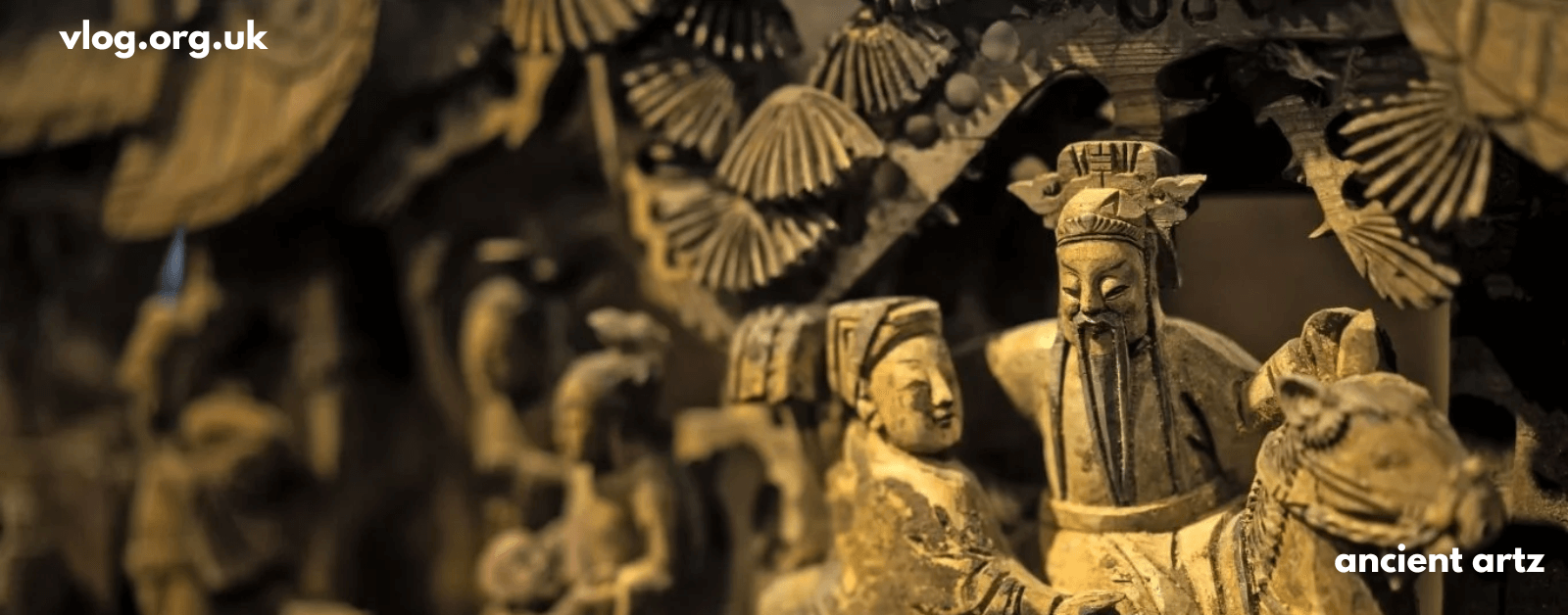
The Timeless Echo of Ancient Art: A Journey Through Civilization
A Journey Thr2ough Time
Art has always whispered the secrets of humanity. From the first stroke on a cave wall to the divine elegance of a temple carving, ancient art embodies the spirit, beliefs, and aspirations of early civilizations. It’s not just pigment on stone or chisel on marble—it’s humanity’s eternal fingerprint.
Prehistoric cave paintings in Lascaux, France and Altamira, Spain ignite our awe. These early depictions of animals and rituals are raw, yet profoundly expressive—art as survival, storytelling, and soul. This journey through time starts with these primal gestures and leads us across millennia of cultural brilliance.
The Origins of Ancient Art
The first humans didn’t just survive—they expressed. In their art, we see not only beauty but identity, community, and spiritual yearning. Prehistoric cave drawings, etched and painted by torchlight, were visual prayers, hunting guides, and tribal memories.
These early masterpieces are among the earliest known forms of visual storytelling and artistic expression. They reveal a complex worldview, merging the physical and spiritual—a signature of ancient artistry that persisted through history.
Major Civilizations Through Time
Across continents, civilizations rose—and each told their stories through art. The Egyptian Civilization, Mesopotamia, the Greek and Roman Empires, the Indus Valley, Chinese Dynasties, the Maya and Aztec Empires, the Celts, and Japan all left indelible marks.
From towering pyramids and temples to delicate jade carvings and illuminated manuscripts, these cultures harnessed a multitude of mediums and symbols. Their legacy endures in the form of enduring monuments, intricate artifacts, and timeless tales engraved in stone and pigment.
Egyptian Art (3000 BCE – 30 BCE)
With stunning precision and spiritual depth, Egyptian art was a window into a world ruled by gods and pharaohs. Think Pyramids of Giza, golden mummies, and the intricate tombs of kings. Art here was not for pleasure—it was a pathway to the afterlife.
Symbolism saturated every work: lotus for rebirth, ankh for life, and falcon for Horus. Artists worked to honor divine order (ma’at), achieving immortality for both their patrons and their culture. The enduring beauty of Shiva Nataraja echoes these sacred ideals.
Mesopotamian Art (3100 BCE – 539 BCE)
Mesopotamia—home of the Sumerians, Babylonians, and Assyrians—birthed civilization and the earliest known city-states. Their art reflected power, divinity, and the glory of kings. Think Standard of Ur, Ishtar Gate, and ziggurat carvings.
Art served as communication—between rulers and subjects, gods and humans. The stories on stone reliefs, cylinder seals, and temple walls reveal both daily life and epic legends, rich with ritualistic symbolism and historical craftsmanship.
Greek Art (800 BCE – 31 BCE)
Greek art radiates beauty, proportion, and intellectual depth. Here, the human body was divine, and gods walked among mortals. The Parthenon stands as a triumph of architecture and design, while sculptures like Venus de Milo mesmerize with their grace.
Mythology in art was central—each piece channeled a narrative, from Athena’s wisdom to Dionysus’s chaos. Artists pursued idealism, balance, and harmony, crafting works that continue to shape Western aesthetics today.
Roman Art (509 BCE – 476 CE)
The Roman Empire built upon Greek ideals but injected grandeur and realism. The Colosseum roars of Roman might, while frescoes and mosaics from Pompeii show the soul of daily life. Roman artists innovated through sculptures and carvings, portraiture, and city planning.
They were also master preservers of cultural heritage, blending Etruscan, Greek, and native Italian elements into a vivid artistic tapestry. Roman art was both decorative and political—a tool of legacy and law.
Indian Art (2500 BCE – Present)
From the Indus Valley Civilization at Mohenjo-Daro to the spiritual beauty of Ajanta and Ellora caves, Indian art is rich with religious symbolism, devotion, and cosmic ideals. Art was ritual, dharma, and moksha—liberation through beauty.
Stunning bronze sculptures, sacred calligraphy, and temple carvings illustrate gods and epics with deep emotion. Shiva Nataraja, the cosmic dancer, spins the rhythm of life in bronze. Indian art continues to evolve but remains rooted in its ancient spiritual roots.
Chinese Art (2000 BCE – Present)
From ancient jade carvings to the majesty of the Terracotta Army, Chinese Dynasties blended philosophy, spirituality, and nature into sublime visual languages. Art was moral, educational, and harmonious.
Calligraphy, ink landscapes, and intricate ceramics shaped a visual legacy. Emperors like Qin Shi Huang used art to assert power and preserve history. Chinese art is serenity in motion—a gentle balance between earth and heaven.
Mesoamerican Art (1200 BCE – 1500 CE)
The Maya Civilization and Aztec Empire forged a world of gods, sacrifice, and celestial calculation. Temples, murals, and glyphs vibrate with spiritual symbolism and awe-inspiring design. The Stone of the Sun symbolizes time, power, and cosmos.
From pyramid-topped cities to feathered headdresses and ceremonial masks, Mesoamerican art reflected life, death, and rebirth. This is art as communication—between the heavens and the people.
African Art: A Celebration of Heritage and Spirituality
African civilizations like the Edo people created masterpieces like the Benin Bronzes, expressing power, lineage, and divine authority. African art is bold, symbolic, and deeply tied to ritual.
Each sculpture, mask, or fabric embodies cultural heritage and spiritual symbolism, passed from generation to generation. These works were not just seen—they were danced, sung, and revered.
Celtic Art: Mystical Patterns and Symbolism
The Celts embraced mystical symbolism, weaving stories in the intricate knots and sacred scrolls of the Book of Kells. Their art is mesmerizing—spirals, animals, and patterns infused with magical belief.
Metalwork, stone carvings, and illuminated manuscripts reflect a deep connection to nature and the unseen. For the Celts, art was a portal between worlds.
Japanese Art: The Beauty of Simplicity
From serene landscapes by Hokusai and Hiroshige to the armor of Samurai, Japanese art values elegance, nature, and impermanence. Its heart is wabi-sabi—the beauty in imperfection.
Minimal yet powerful, it reflects the cultural harmony of Japan. Whether in a brushstroke or a Noh mask, Japanese art speaks in whispers that resonate like thunder.
Some Mediums Used for Ancient Art
Ancient art was crafted with awe-inspiring ingenuity: ceramics and pottery, bronze, gold, wood, ivory, jade, stone, and ink. Each medium had purpose—ritual, utility, storytelling.
From illuminated manuscripts to sculptures and carvings, these materials embodied not just form but meaning. Ancient artists were also engineers, chemists, and visionaries.
Symbolism in Ancient Art
Every line, color, and object held meaning. A lion wasn’t just a lion—it was strength. A lotus wasn’t just a flower—it was eternity. Artistic symbolism was the language of the divine and mortal.
Symbols crossed borders, merging faith, power, and nature. They bound communities, documented beliefs, and connected past with future.
Significance
Ancient art isn’t relics—it’s identity. It teaches, unites, and inspires. It survives wars, empires, and time itself, whispering wisdom and wonder into the modern age.
Its artistic legacy lives in every gallery, every mural, every creative spark. From cave walls to digital screens, ancient art breathes through us.
The Influence of Ancient Art on Modern Creativity
Modern architecture, fashion, film, and design echo ancient motifs. We borrow their architecture, symbols, and spirit. Greek columns, Roman arches, Japanese prints—still relevant, still revered.
Designers study their forms. Artists mimic their balance. Philosophers echo their meanings. Ancient art’s visual storytelling shapes our imagination.
Preserving Ancient Art for Future Generations
Preservation is vital. Through restoration techniques, museums, and cultural policies, we protect these treasures. It’s more than saving art—it’s saving memory.
Preserving ancient art ensures that future generations feel the same awe, same connection, same spirit that defined our ancestors.
Conclusion
Ancient art is more than beauty. It’s a bridge—linking generations, cultures, and minds. It lives in stone, bronze, and ink. It echoes across time with eternal relevance.
Let us honor it. Let us preserve it. Let us continue its legacy.
FAQs on Ancient Art
Q: What is the oldest known ancient art?
A: The oldest known art includes cave paintings from Lascaux, France and Altamira, Spain, dating back over 17,000 years.
Q: Why was art important in ancient civilizations?
A: Art was a vital tool for storytelling, religious rituals, political expression, and cultural identity.
Q: What materials did ancient artists use?
A: Common mediums included stone, bronze, pottery, jade, wood, and pigments from natural sources.
Q: How did ancient art influence modern art?
A: Ancient principles like symmetry, symbolism, and storytelling continue to shape modern architecture, painting, and design.
Q: Can ancient art still be seen today?
A: Yes, many artifacts and artworks are preserved in museums, temples, caves, and heritage sites around the world.
Read Next :-Amikaf16




